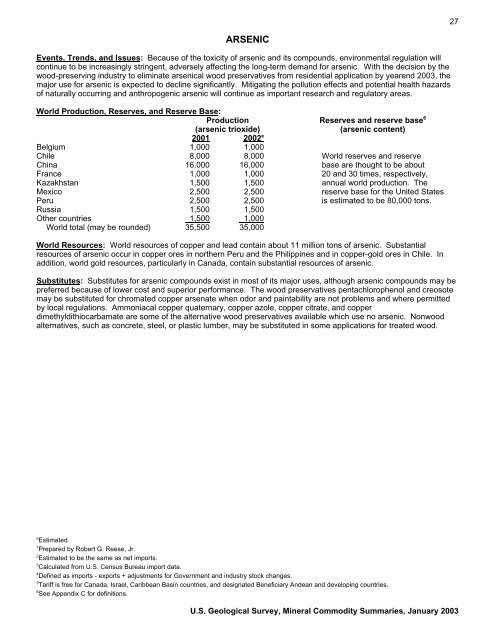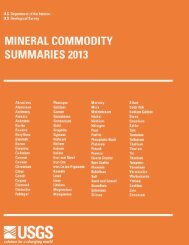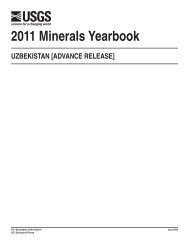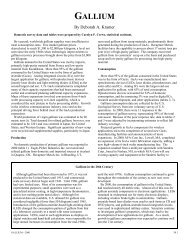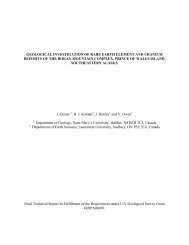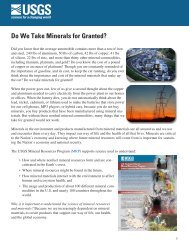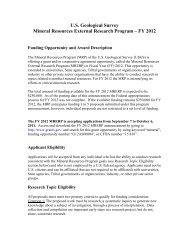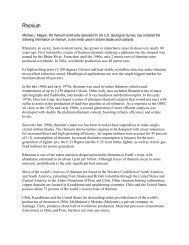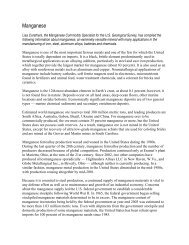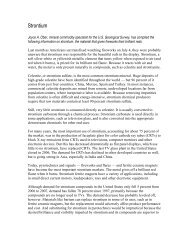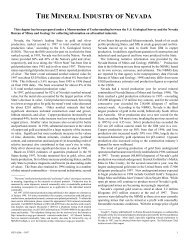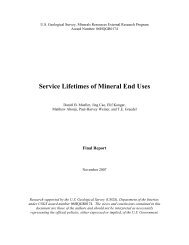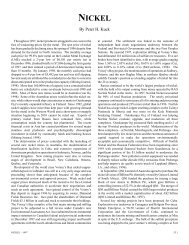Mineral Commodity Summaries 2003 - Mineral Resources Program ...
Mineral Commodity Summaries 2003 - Mineral Resources Program ...
Mineral Commodity Summaries 2003 - Mineral Resources Program ...
You also want an ePaper? Increase the reach of your titles
YUMPU automatically turns print PDFs into web optimized ePapers that Google loves.
ARSENIC<br />
Events, Trends, and Issues: Because of the toxicity of arsenic and its compounds, environmental regulation will<br />
continue to be increasingly stringent, adversely affecting the long-term demand for arsenic. With the decision by the<br />
wood-preserving industry to eliminate arsenical wood preservatives from residential application by yearend <strong>2003</strong>, the<br />
major use for arsenic is expected to decline significantly. Mitigating the pollution effects and potential health hazards<br />
of naturally occurring and anthropogenic arsenic will continue as important research and regulatory areas.<br />
World Production, Reserves, and Reserve Base:<br />
Production Reserves and reserve base 6<br />
(arsenic trioxide) (arsenic content)<br />
2001 2002 e<br />
Belgium 1,000 1,000<br />
Chile 8,000 8,000 World reserves and reserve<br />
China 16,000 16,000 base are thought to be about<br />
France 1,000 1,000 20 and 30 times, respectively,<br />
Kazakhstan 1,500 1,500 annual world production. The<br />
Mexico 2,500 2,500 reserve base for the United States<br />
Peru 2,500 2,500 is estimated to be 80,000 tons.<br />
Russia 1,500 1,500<br />
Other countries 1,500 1,000<br />
World total (may be rounded) 35,500 35,000<br />
World <strong>Resources</strong>: World resources of copper and lead contain about 11 million tons of arsenic. Substantial<br />
resources of arsenic occur in copper ores in northern Peru and the Philippines and in copper-gold ores in Chile. In<br />
addition, world gold resources, particularly in Canada, contain substantial resources of arsenic.<br />
Substitutes: Substitutes for arsenic compounds exist in most of its major uses, although arsenic compounds may be<br />
preferred because of lower cost and superior performance. The wood preservatives pentachlorophenol and creosote<br />
may be substituted for chromated copper arsenate when odor and paintability are not problems and where permitted<br />
by local regulations. Ammoniacal copper quaternary, copper azole, copper citrate, and copper<br />
dimethyldithiocarbamate are some of the alternative wood preservatives available which use no arsenic. Nonwood<br />
alternatives, such as concrete, steel, or plastic lumber, may be substituted in some applications for treated wood.<br />
e Estimated.<br />
1 Prepared by Robert G. Reese, Jr.<br />
2 Estimated to be the same as net imports.<br />
3 Calculated from U.S. Census Bureau import data.<br />
4 Defined as imports - exports + adjustments for Government and industry stock changes.<br />
5 Tariff is free for Canada, Israel, Caribbean Basin countries, and designated Beneficiary Andean and developing countries.<br />
6 See Appendix C for definitions.<br />
U.S. Geological Survey, <strong>Mineral</strong> <strong>Commodity</strong> <strong>Summaries</strong>, January <strong>2003</strong><br />
27


